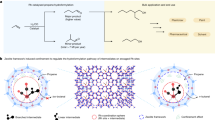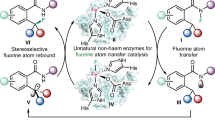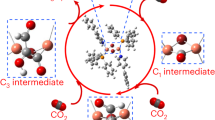Abstract
C–C coupling is a critical step of CO2 fixation in constructing the carbon skeleton of value-added multicarbon products. The Wood–Ljungdahl pathway is an efficient natural process through which microbes transform CO2 into methyl and carbonyl groups and subsequently couple them together. This asymmetric coupling mechanism remains largely unexplored in inorganic CO2 electroreduction. Here we experimentally validate the asymmetric coupling pathway through isotope-labelled co-reduction experiments on a Cu surface where 13CH3I and 12CO are co-fed externally as the methyl and the carbonyl source, respectively. Isotope-labelled multicarbon oxygenates were detected, which confirms an electrocatalytic asymmetric coupling on the Cu surface. We further employed tandem Cu–Ag nanoparticle systems in which *CHx and *CO intermediates can be generated to achieve asymmetric C–C coupling for a practical CO2 electroreduction. We found that the production of multicarbon oxygenates is correlated with the generation rate of two intermediate indicators, CH4 and CO. By aligning their rates, the oxygenates generation rate can be maximized.

This is a preview of subscription content, access via your institution
Access options
Access Nature and 54 other Nature Portfolio journals
Get Nature+, our best-value online-access subscription
$29.99 / 30 days
cancel any time
Subscribe to this journal
Receive 12 digital issues and online access to articles
$119.00 per year
only $9.92 per issue
Buy this article
- Purchase on Springer Link
- Instant access to full article PDF
Prices may be subject to local taxes which are calculated during checkout




Similar content being viewed by others
Data availability
All data is available from the authors upon reasonable request.
References
Jordaan, S. M. & Wang, C. Electrocatalytic conversion of carbon dioxide for the Paris goals. Nat. Catal. 4, 915–920 (2021).
Ross, M. B. et al. Designing materials for electrochemical carbon dioxide recycling. Nat. Catal. 2, 648–658 (2019).
Habisreutinger, S. N., Schmidt-Mende, L. & Stolarczyk, J. K. Photocatalytic reduction of CO2 on TiO2 and other semiconductors. Angew. Chem. Int. Ed. 52, 7372–7408 (2013).
Jasniewski, A. J., Lee, C. C., Ribbe, M. W. & Hu, Y. Reactivity, mechanism, and assembly of the alternative nitrogenases. Chem. Rev. 120, 5107–5157 (2020).
Marques Mota, F. & Kim, D. H. From CO2 methanation to ambitious long-chain hydrocarbons: alternative fuels paving the path to sustainability. Chem. Soc. Rev. 48, 205–259 (2019).
Can, M., Armstrong, F. A. & Ragsdale, S. W. Structure, function, and mechanism of the nickel metalloenzymes, CO dehydrogenase, and acetyl-CoA synthase. Chem. Rev. 114, 4149–4174 (2014).
Ragsdale, S. W. & Pierce, E. Acetogenesis and the Wood–Ljungdahl pathway of CO2 fixation. Biochim. Biophys. Acta 1784, 1873–1898 (2008).
Nitopi, S. et al. Progress and perspectives of electrochemical CO2 reduction on copper in aqueous electrolyte. Chem. Rev. 119, 7610–7672 (2019).
Hori, Y., Murata, A. & Takahashi, R. Formation of hydrocarbons in the electrochemical reduction of carbon dioxide at a copper electrode in aqueous solution. J. Chem. Soc. Faraday Trans. 1 85, 2309–2326 (1989).
Montoya, J. H., Shi, C., Chan, K. & Norskov, J. K. Theoretical insights into a CO dimerization mechanism in CO2 electroreduction. J. Phys. Chem. Lett. 6, 2032–2037 (2015).
Wang, L. et al. Electrochemical carbon monoxide reduction on polycrystalline copper: effects of potential, pressure, and pH on selectivity toward multicarbon and oxygenated products. ACS Catal. 8, 7445–7454 (2018).
Hanselman, S., Koper, M. T. M. & Calle-Vallejo, F. Computational comparison of late transition metal (100) surfaces for the electrocatalytic reduction of CO to C2 species. ACS Energy Lett. 3, 1062–1067 (2018).
Perez-Gallent, E., Figueiredo, M. C., Calle-Vallejo, F. & Koper, M. T. Spectroscopic observation of a hydrogenated CO dimer intermediate during CO reduction on Cu(100) electrodes. Angew. Chem. Int. Ed. 56, 3621–3624 (2017).
Kim, Y. et al. Time-resolved observation of C–C coupling intermediates on Cu electrodes for selective electrochemical CO2 reduction. Energy Environ. Sci. 13, 4301–4311 (2020).
Xiao, H., Cheng, T., Goddard, W. A. & Sundararaman, R. Mechanistic explanation of the pH dependence and onset potentials for hydrocarbon products from electrochemical reduction of CO on Cu(111). J. Am. Chem. Soc. 138, 483–486 (2016).
Xiao, H., Cheng, T. & Goddard, W. A. Atomistic mechanisms underlying selectivities in C1 and C2 products from electrochemical reduction of CO on Cu(111). J. Am. Chem. Soc. 139, 130–136 (2017).
Zhao, Q., Martirez, J. M. P. & Carter, E. A. Revisiting understanding of electrochemical CO2 reduction on Cu(111): competing proton-coupled electron transfer reaction mechanisms revealed by embedded correlated wavefunction theory. J. Am. Chem. Soc. 143, 6152–6164 (2021).
Ma, W. et al. Electrocatalytic reduction of CO2 to ethylene and ethanol through hydrogen-assisted C–C coupling over fluorine-modified copper. Nat. Catal. 3, 478–487 (2020).
Choi, C. et al. Highly active and stable stepped Cu surface for enhanced electrochemical CO2 reduction to C2H4. Nat. Catal. 3, 804–812 (2020).
Garza, A. J., Bell, A. T. & Head-Gordon, M. Mechanism of CO2 reduction at copper surfaces: pathways to C2 products. ACS Catal. 8, 1490–1499 (2018).
Schouten, K. J., Qin, Z., Perez Gallent, E. & Koper, M. T. Two pathways for the formation of ethylene in CO reduction on single-crystal copper electrodes. J. Am. Chem. Soc. 134, 9864–9867 (2012).
Cheng, T., Xiao, H. & Goddard, W. A. Full atomistic reaction mechanism with kinetics for CO reduction on Cu(100) from ab initio molecular dynamics free-energy calculations at 298 K. Proc. Natl Acad. Sci. USA 114, 1795–1800 (2017).
Dinh, C.-T. et al. CO2 electroreduction to ethylene via hydroxide-mediated copper catalysis at an abrupt interface. Science 360, 783–787 (2018).
Luc, W. et al. Two-dimensional copper nanosheets for electrochemical reduction of carbon monoxide to acetate. Nat. Catal. 2, 423–430 (2019).
Kim, C. et al. Tailored catalyst microenvironments for CO2 electroreduction to multicarbon products on copper using bilayer ionomer coatings. Nat. Energy 6, 1026–1034 (2021).
Vasileff, A. et al. Electrochemical reduction of CO2 to ethane through stabilization of an ethoxy intermediate. Angew. Chem. Int. Ed. 132, 19817–19821 (2020).
Ren, D., Ang, B. S.-H. & Yeo, B. S. Tuning the selectivity of carbon dioxide electroreduction toward ethanol on oxide-derived CuxZn catalysts. ACS Catal. 6, 8239–8247 (2016).
Iyengar, P., Kolb, M. J., Pankhurst, J. R., Calle-Vallejo, F. & Buonsanti, R. Elucidating the facet-dependent selectivity for CO2 electroreduction to ethanol of Cu–Ag tandem catalysts. ACS Catal. 11, 4456–4463 (2021).
Ting, L. R. L. et al. Enhancing CO2 electroreduction to ethanol on copper–silver composites by opening an alternative catalytic pathway. ACS Catal. 10, 4059–4069 (2020).
Raaijman, S. J., Schellekens, M. P., Corbett, P. J. & Koper, M. T. M. High-pressure CO electroreduction at silver produces ethanol and propanol. Angew. Chem. Int. Ed. 60, 21732–21736 (2021).
Kas, R. et al. In‐situ infrared spectroscopy applied to the study of the electrocatalytic reduction of CO2: theory, practice and challenges. ChemPhysChem 20, 2904–2925 (2019).
Sebastián-Pascual, P. & Escudero-Escribano, M. Surface characterization of copper electrocatalysts by lead underpotential deposition. J. Electroanal. Chem. 896, 115446 (2021).
Chen, Y. Recent advances in methylation: a guide for selecting methylation reagents. Chem. Eur. J. 25, 3405–3439 (2019).
Zhang, W. et al. Electrochemically driven cross-electrophile coupling of alkyl halides. Nature 604, 292–297 (2022).
Fedurco, M., Sartoretti, C. J. & Augustynski, J. Reductive cleavage of the carbon−halogen bond in simple methyl and methylene halides. Reactions of the methyl radical and carbene at the polarized electrode/aqueous solution interface. Langmuir 17, 2380–2387 (2001).
Lin, J. L. & Bent, B. E. Two mechanisms for formation of methyl radicals during the thermal decomposition of methyl iodide on a copper surface. J. Phys. Chem. 97, 9713–9718 (1993).
Lei, C., Liang, F., Li, J., Chen, W. & Huang, B. Electrochemical reductive dechlorination of chlorinated volatile organic compounds (Cl-VOCs): effects of molecular structure on the dehalogenation reactivity and mechanisms. Chem. Eng. J. 358, 1054–1064 (2019).
Gunathunge, C. M., Ovalle, V. J., Li, Y., Janik, M. J. & Waegele, M. M. Existence of an electrochemically inert CO population on Cu electrodes in alkaline pH. ACS Catal. 8, 7507–7516 (2018).
Li, J., Li, X., Gunathunge, C. M. & Waegele, M. M. Hydrogen bonding steers the product selectivity of electrocatalytic CO reduction. Proc. Natl Acad. Sci. USA 116, 9220–9229 (2019).
Chang, X., Malkani, A., Yang, X. & Xu, B. Mechanistic insights into electroreductive C–C coupling between CO and acetaldehyde into multicarbon products. J. Am. Chem. Soc. 142, 2975–2983 (2020).
Van Santen, R., Markvoort, A., Filot, I., Ghouri, M. & Hensen, E. Mechanism and microkinetics of the Fischer–Tropsch reaction. Phys. Chem. Chem. Phys. 15, 17038–17063 (2013).
Zhao, Y. et al. Direct C–C coupling of CO2 and the methyl group from CH4 activation through facile insertion of CO2 into Zn–CH3 σ-bond. J. Am. Chem. Soc. 138, 10191–10198 (2016).
Zhao, Y., Wang, H., Han, J., Zhu, X. & Ge, Q. Active site ensembles enabled C–C coupling of CO2 and CH4 for acetone production. J. Phys. Chem. C 122, 9570–9577 (2018).
Kim, D. et al. Selective CO2 electrocatalysis at the pseudocapacitive nanoparticle/ordered-ligand interlayer. Nat. Energy 5, 1032–1042 (2020).
Hung, L. I., Tsung, C. K., Huang, W. & Yang, P. Room‐temperature formation of hollow Cu2O nanoparticles. Adv. Mater. 22, 1910–1914 (2010).
Kim, D., Kley, C. S., Li, Y. & Yang, P. Copper nanoparticle ensembles for selective electroreduction of CO2 to C2–C3 products. Proc. Natl Acad. Sci. USA 114, 10560–10565 (2017).
Manthiram, K., Beberwyck, B. J. & Alivisatos, A. P. Enhanced electrochemical methanation of carbon dioxide with a dispersible nanoscale copper catalyst. J. Am. Chem. Soc. 136, 13319–13325 (2014).
Huang, J., Mensi, M., Oveisi, E., Mantella, V. & Buonsanti, R. Structural sensitivities in bimetallic catalysts for electrochemical CO2 reduction revealed by Ag–Cu nanodimers. J. Am. Chem. Soc. 141, 2490–2499 (2019).
Gu, J., Hsu, C.-S., Bai, L., Chen, H. M. & Hu, X. Atomically dispersed Fe3+ sites catalyze efficient CO2 electroreduction to CO. Science 364, 1091–1094 (2019).
Wang, L. et al. Selective reduction of CO to acetaldehyde with CuAg electrocatalysts. Proc. Natl Acad. Sci. USA 117, 12572–12575 (2020).
Acknowledgements
This work was supported by the Director, Office of Science, Office of Basic Energy Sciences, Chemical Sciences, Geosciences and Biosciences Division of the US Department of Energy under contract DE-AC02-05CH11231, FWP CH030201 (Catalysis Research Program). STEM–EDX and XPS were conducted using facilities at the Molecular Foundry. Work at the Molecular Foundry was supported by the Office of Science, Office of Basic Energy Sciences of the US Department of Energy under contract no. DE-AC02-05CH11231. The STEM–EELS work made use of the TEM facilities (Nion UltraSTEM) at the Cornell Center for Materials Research (CCMR), which are supported through the National Science Foundation Materials Research Science and Engineering Center (NSF MRSEC) program (DMR-1719875). We thank the TEM technical support of R. Dhall and K. Bustillo at NCEM and of M. Thomas at Cornell. We thank H. Celik and UC Berkeley’s NMR facility in the College of Chemistry (CoC-NMR) for spectroscopic assistance. Instruments in the CoC-NMR are supported in part by NIH S10OD024998. C.C. and J.J. gratefully acknowledge support from Suzhou Industrial Park Scholarships. S.Y. acknowledges support from a Samsung Scholarship. Y.Y. acknowledges support from a Miller Research Fellowship. P.-C.C. acknowledges support from a Kavli ENSI Heising-Simons Fellowship.
Author information
Authors and Affiliations
Contributions
C.C., S.Y. and P.Y. conceived the research and designed the experiments. C.C. conducted the isotope labelling experiments and S.Y. conducted the NP synthesis and CO2 electrolysis with assistance from S.L., I.R., S.C. and Y.S. Electron microscopy characterization and structural analysis were conducted by Y.Y., J.J. and P.-C.C. All the authors contributed to the discussion of the experimental results and the preparation of the manuscript.
Corresponding author
Ethics declarations
Competing interests
The authors declare no competing interests.
Peer review
Peer review information
Nature Catalysis thanks Bo Yang, Xinli Zhu and the other, anonymous, reviewer(s) for their contribution to the peer review of this work.
Additional information
Publisher’s note Springer Nature remains neutral with regard to jurisdictional claims in published maps and institutional affiliations.
Supplementary information
Supplementary Information
Supplementary Figs. 1–9 and Table 1.
Rights and permissions
Springer Nature or its licensor holds exclusive rights to this article under a publishing agreement with the author(s) or other rightsholder(s); author self-archiving of the accepted manuscript version of this article is solely governed by the terms of such publishing agreement and applicable law.
About this article
Cite this article
Chen, C., Yu, S., Yang, Y. et al. Exploration of the bio-analogous asymmetric C–C coupling mechanism in tandem CO2 electroreduction. Nat Catal 5, 878–887 (2022). https://doi.org/10.1038/s41929-022-00844-w
Received:
Accepted:
Published:
Issue Date:
DOI: https://doi.org/10.1038/s41929-022-00844-w
This article is cited by
-
A surface strategy boosting the ethylene selectivity for CO2 reduction and in situ mechanistic insights
Nature Communications (2024)
-
Solar-driven sugar production directly from CO2 via a customizable electrocatalytic–biocatalytic flow system
Nature Communications (2024)
-
Potential and electric double-layer effect in electrocatalytic urea synthesis
Nature Communications (2024)
-
Theoretical Study on the Electroreduction of CO2 to α-Olefins by Tandem Catalysis of Polymetallic Phthalocyanine Two-Dimensional Carbon-Rich Conjugated Frameworks (CCFs)
Electrocatalysis (2024)
-
Atomic Dispersed Hetero-Pairs for Enhanced Electrocatalytic CO2 Reduction
Nano-Micro Letters (2024)



